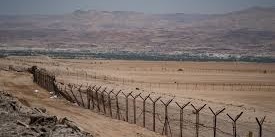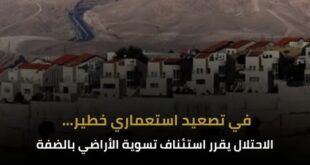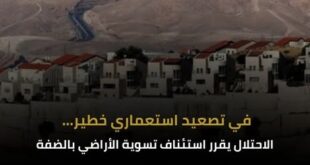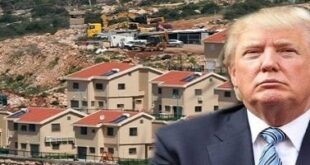By: Madeeha Al-A’raj
The National Bureau for Defending Land and Resisting Settlements stated in its latest weekly report , that Israeli inner cabinet approved last Sunday a plan that includes the construction of a ‘security’ wall on the eastern border with Jordan, and strengten settlement in the area through establishing military schools, agricultural farms, and new infrastructure, which under Israeli estimates are tools that reflect the occupation government’s approach to deepening settlement, and transforming it into vital area for its settlement activities and plans. As usual, the occupation government justified this step by lies and misleads, claiming that it aims to confront Iran’s attempts to transform the eastern border into a terrorist front, while at the same time aiming to strengthen settlement and control over the Jordan Valley.
A joint ministerial team, headed by the Director-General of the Israeli Ministry of Army, Amir Baram, will draft a five-year plan that includes the establishment of a multi-layered defense system along 425 km of the border extending from the southern part of the occupied Syrian Golan Heights to the northern part of the Eilat city. The plan includes advanced defense technologies, physical barriers, sensors, detection and warning systems, information and communications technology, and the deployment of flexible and light combat units adapted to the terrain. To further mislead public opinion, the occupation army announced on the same day that it ‘thwarted within 48 hours 2 infiltration attempts across the Jordan border’ by the heroes, unfortunately for Israel, holding Sri-Lankan’s nationality.
For his part, Israeli Army Minister, Katz announced last March that Israel intends to build this wall, adding that the primary goal is to prevent arms smuggling and thwart attempts to establish an eastern terrorist front led by Iran, with a focus on encouraging settlement by building settlements along it. According to the plan presented, it costs NIS 5.2 billion, and the Border and Seam Directorate will participate in its implementation, along with army units and various security apparatuses. According to the ‘Israel Hayom’ Newspaper, the plan is the result of a joint initiative by government ministers Yisrael Katz, Orit Struck, and Bezalel Smotrich, who seek to employ ‘merge between the army and settlements’ as a means of strengthening control over the eastern border extending from the northern Jordan Valley to Eilat.
The newspaper revealed that the FM has already allocated NIS 50 million to fund the first phase of the plan, before the allocation was raised to NIS 80 million during cabinet deliberations, most of which will be transferred to the Settlement Ministry. The plan’s agricultural aspect includes developing about 4,000 donums on the border into grazing and agricultural farms, in addition to establishing mobile student housing units, which will enhance the ‘civilian-security’ nature of the border settlements, according to the project’s organizers.
The plan includes 2 phases, starts with a pilot one till the end of this year, includes the establishment of Nahal Military Bases, and religious and preparatory institutions ahead of military service, some of which will be specifically targeted at the ultra-Orthodox community. Settlement Minister Orit Struck will oversee the civilian aspects of the plan, including the establishment of pastoral farms and student villages, and the distribution of educational and religious institutions to ensure continuous settlement continuity along the border.
The plan also includes the development of a new model for ultra-Orthodox institutes that integrates religious education with border guard duties and allows for the establishment of temporary settlement outposts to receive new settlers and provide their families with land and transitional housing until their presence within the settlements is established, with priority given to the families of reserve soldiers. According to Israeli Army Minister, Katz, the construction of the wall represents a strategic measure to counter attempts to transform the Jordanian border into a hostile front. He emphasized the connection between this wall and the ongoing war in the West Bank, which, he described, will strengthen ‘Israeli sovereignty in the Jordan Valley at the long term.’
For her part, Settlement Minister, Strook considered that ‘the most important lesson from the events of Oct. 7’ is that settlement is the source of security, calling for this concept to be translated into practice by intensifying the demographic and settlement presence in the East. As for the Minister of Finance, Smotrich, he saw the decision as a ‘historic step’ on the path to imposing Israeli sovereignty, expressing his pride in leading this project and providing the necessary funding for it in next year’s budget.
But does the security pretext regarding the Jordan Valley convince anyone! In all international reactions to Israel’s settlement projects in the West Bank, including the Jordan Valley, the positions have been clear: peace and a political settlement of the conflict, not illegal settlements, enhance security for all parties, including the Israeli side. In any case, the facts remain the basis; the occupying state’s ambitions in the Jordan Valley extend for many years, ranging from thieving the area to attempting to control it by leasing it for decades as part of an expansionist strategy pursued by Israeli governments, specifically those headed by Netanyahu. It was evident even before US President Trump announced his plan for a political settlement in Jan. 2020.
As part of the occupation’s intention to annex the Jordan Valley and the northern Dead Sea, Israeli PM Netanyahu said, prior to his Dec. 2019 trip to Lisbon, Portugal, to meet with former US Secretary of State Mike Pompeo, that he would discuss several issues with him, including US recognition of Israel’s annexation of the Jordan Valley. At the time, Netanyahu reiterated his statements about imposing ‘Israeli sovereignty’ over the Jordan Valley and the northern Dead Sea, with political cover from the US Administration. He also explicitly announced this during his campaign for the Knesset elections in September 2019 without linking this to alleged threats to his country’s security from the Islamic Republic of Iran.
He also affirmed that he would impose Israeli sovereignty over the Jordan Valley and the northern Dead Sea area in the West Bank if re-elected. This was stated in a televised address to the settler community and the electoral base of the right-wing and far-right parties, in an attempt to bolster Likud’s position in those elections. He said, ‘There is one place where we can apply Israeli sovereignty immediately after the elections,’ adding in a message to voters, ‘If I receive a clear mandate from you to do so. I announce today my intention to establish Israeli sovereignty over the Jordan Valley and the northern Dead Sea.’
It is worth noting that the Jordan Valley and the northern Dead Sea are a vast area, covering 24% of the West Bank, which constitutes the food basket of the Palestinians. They control about 12% of the lands of the Jordan Valley ‘southern, central and northern’, and are home to more than 65,000 Palestinians. They include 27 permanent population centers on an area of 10,000 dunams, and scores of pastoral and Bedouin communities. They are administratively affiliated with three governorates: Tubas Governorate ‘Northern Valley’, which has 11 communities; Nablus Governorate ‘Central Valley’, which has 4 communities; and Jericho Governorate ‘Southern Jordan Valley’, which has 12 communities.
A research paper issued by the Institute for Palestine Studies, published in Sep. 2024, entitled ‘The Reality of the Agricultural Sector in the Jordan Valley after Oct. 7, 2023,” indicates that ‘before 1967, the Jordan Valley was home to about 320,000 Palestinians, but this number has decreased significantly due to the ongoing forced displacement policies implemented by the occupation’.
Today, the number of Palestinians in the Jordan Valley doesn’t exceed 65,000, distributed across 27 population centers ‘Palestinian Central Bureau of Statistics, 2023’. Meanwhile, the number of Israeli settlers has doubled to more than 15,000, living in 37 settlements that seize over 50% of agricultural land ‘B’Tselem, 2023’. These demographic shifts aim to alter the demographic composition of the Jordan Valley and facilitate Israeli control over the region.
As for water, the Jordan Valley lies within the Eastern Aquifer, the second-largest groundwater reservoir in the West Bank, with a capacity of 173 million cubic meters and containing 50% of Palestine’s water resources. The occupation controls 85% of the Jordan Valley’s water resources. As for water consumption, an Israeli settler consumes about 287 liters of water per day, while the average Palestinian consumes no more than 20 liters per day.
In the Jordan Valley, there are about 11,000 settlers living in three regional councils: the Jordan Valley Council, the Dead Sea Council, and the Ma’ale Ephraim Council. These councils are distributed among these settlements, in addition to dozens of outposts and pastoral farms. According to reports issued by the Settlements Council, Israel earns between $ 650 – 750 million annually from the Jordan Valley settlements. The occupation earns more from the Jordan Valley than all of the Palestinian Authority’s exports to the Israeli occupation state. By denying Palestinians control and investment in this area, Israel is dealing a severe blow to the Palestinian economy, especially since the Jordan Valley is considered the key to sustainable development for the national economy and is Palestine’s breadbasket. However, it is a basket that is being completely emptied by the occupation.
According to reports from various sources, including the World Bank, the losses to Palestinians as a result of being denied access to their legitimate resources in the Jordan Valley and the Dead Sea amount to $ 3.4 billion annually, not to mention the Palestinian Authority’s deprivation of providing tens of thousands of job opportunities for Palestinians. According to the Israeli Information Center for Human Rights in the Occupied Territories ‘B’Tselem’, ‘Israel denies Palestinians access to approximately 85% of the Jordan Valley and the northern Dead Sea, exploiting this area for its own needs.’ Israel bases these practices on various pretexts and classifications, including “closed areas,” “firing zones,” “nature reserves,” and “national parks.” It has also allocated additional land for settlements established in the Jordan Valley shortly after the occupation. ‘B’Tselem’.
The latest evidence of Israeli ambitions in the Palestinian Jordan Valley was reported by the Ma’ariv Newspaper regarding the approval of extremist FM Smotrich to bring aid into the Gaza Strip. This approval didn’t come without a price, and his silence, as Ma’ariv says, regarding the decision to bring this aid in came as a result of a political deal with Netanyahu that stipulates the expansion of settlements in the occupied West Bank, especially in the Jordan Valley, and the construction of hundreds of settlement units, in exchange for this approval.
Under the agreement, Netanyahu will approve the construction of hundreds of new housing units in the settlement outposts, through settlement nuclei and settlement agricultural farms along the eastern border. These nuclei will be funded by the Ministry of Settlement, headed by Minister Orit Strook, who will receive a significant budget increase for this purpose, after the Ministerial Council for Political and Security Affairs i.e. the cabinet approved the project last Monday, in conjunction with the approval to bring humanitarian aid into Gaza.
In addition to what reported by Channel 14 that there is a plan to approve Smotrich’s request regarding 22 settlements in the West Bank. Noting that, the head of the Religious Zionism Party, Bezalel Smotrich, told the Makor Rishon Newspaper at the end of last April, ‘If even a single piece of humanitarian aid enters and reaches Hamas, I will leave the government and the cabinet.’
Unconnectedly, the Peace Now Movement said that the archaeological excavations carried out by the occupation authorities at the archaeological site in the Sebastia town are part of a project to establish a tourist settlement with investments amounting to tens of millions of shekels in the heart of a densely populated Palestinian area in the northern West Bank. The project is part of the Israeli government’s plan to develop the Sebastia archaeological park as part of the settlement tourist sites, benefiting the Israeli public in general and the settlers in particular.
It said that Israel has allocated NIS 32 million equal to ‘$ 9 million’ from the State budget as part of the government’s plan to develop tourist settlements in the West Bank. It noted that, in addition to the Shavei Shomron settlement, the occupation authorities are working to expand their presence in one of the most densely populated Palestinian areas in the West Bank, on the outskirts of Nablus.
List of Israeli Assaults over the Last Week Documented by the National Bureau:
Jerusalem:
- Announcing the imminent opening of a settlement ‘sports club’ in the Ras al-Amud Neighborhood in the Silwan town, in the ‘Ma’ale HaZeitim settlement’, which was forcibly established on the lands of citizens there, as a practical embodiment of the policy of imposing facts on the ground and completing the rings of the settlement ring around the Old City.
- Opening a ‘park’ named after ‘Moshe Arnes’, a member of the Zionist ‘Irgun’ organization that committed massacres against the Palestinian people during the Nakba in 1948.
- Demolishing houses in the city and forced citizen Khalil Abu Mayala to demolish his building that consists of 5 residential apartments under construction in the Shuafat camp under the pretext of lacking a license.
- Forcing Iyad Musa Abu Mayala to demolish the building added to a building in the Al-Awqaf Neighborhood in the Shuafat camp, threatening him that if he didn’t demolish the added building, the occupation municipality would force him to pay NIS 800,000 If it did so. Moreover, it forced the Jerusalemite citizen, Firas Abu Farha, to demolish his own house. This property is home to five people, and after the demolition, the family became homeless. It also forced the Jerusalemite, Osama Dabash, to demolish his house in Sur Baher under the pretext of lacking a license.
- Targeting a room and sheep barns in the eastern lands of the Al-Issawiya village without prior warning, belonging to the citizen Ziad Mustafa. it didn’t stop there, but rather destroyed 10 water tanks and damaged new rooms for horses.
- Demolishing a sheep barn belonging to the Jerusalemite, Majdi Mustafa, in the eastern lands of the village of Al-Issawiya in occupied Jerusalem, for the second time in a row. Meanwhile, the occupation municipality forced the Jerusalemite, Raafat Dabash, to demolish his son’s house and closed the house he lives in in the Sur Baher town under the pretext of building without a permit.
Hebron:
- Assaulting 3 foreign activists while they were documenting the attack on shepherds and farmers in Susya in Masafer Yatta.
- Organizing a provocative march that toured the streets and neighborhoods of the closed areas of Hebron under the protection of the occupation forces, the march set off from the ‘Kiryat Arba settlement’ and passed through the closed neighborhoods of Hebron.
- Injuring a two-year-old girl, and suffered bruises to her head after a settler attacked her while she was returning home with her mother near the occupation checkpoint at the entrance to Shuhada Street in central Hebron.
- Burning fruit trees and crops, the fire spread to large areas of more than 70 donums planted with barley, clover, and other crops in the ‘Khallet al-Forn’ village. These attacks aim to displace residents and expand the ‘Adurin settlement outpost’ and the ‘Bnei Hefer settlement’, which are built on citizens’ lands near the village.
- Destroying the power generators in the Khirbet Aqwawis in Masafer Yatta, that supply the village.
- Attacking citizen Akram Sari Abu Subha and his wife, who sustained bruises and contusions after settlers attacked them in Khirbet Al-Fakhit in Masafer Yatta, after they destroyed a vehicle and cameras in the village’s school after storming it.
- Bulldozing dozens of dunams of citizens’ land in Masafer Yatta, in preparation for seizing it. Noting that the occupation forces informed the landowners of their intention to seize them after they declared that they were their lands, and they told them not to approach them.
Bethlehem:
- Attacking residents of the al-Minya desert, east of Bethlehem, under the protection of Israeli occupation forces, in the Rabia area, forcing them at gunpoint to leave their land.
- Demolishing a park in the Ash Ghurab area of Beit Sahour, which included a wedding hall.
Ramallah:
- Burning agricultural crops and pursued shepherds near the Turmus=Ayya town before residents were able to extinguish the fires and prevent them from spreading.
- Establishing a new settlement outpost among the homes of residents in the Bedouin community of Maghayer al-Deir to the east of Deir Dibwan.
- Bulldozing a house after a military force stormed the Shuqba village, accompanied by bulldozers, and began demolishing a house belonging to Ibrahim Abdel Qader Shalash, under the pretext of building in Area C.
- Handing over orders to stop construction on four houses in the al-Mughayir village, under the pretext of building in Area C.
- Injuring a number of citizens by settler and occupation forces’ gunfire in the Beit-Ilo village after they attacked several homes, firing live ammunition and tear gas canisters.
Nablus:
- Setting fire to large areas of land in the southwestern Duma town, engulfing hundreds of dunams of land, some of which were planted with olive trees.
- Attacking vehicles with stones near the Al-Sawiya village on the road between Nablus and Ramallah, near the village junction, damaging several vehicles.
Salfeet:
- Closing main and secondary roads in the Salfeet Governorate that witnessed a dangerous escalation by the occupation forces and settlers over the past week, bulldozed lands, stormed towns, and targeted citizens and their property as part of a policy of collective punishment aimed at displacing residents and expanding the area of settlement in the region. Mayor of Bruqin, Faed Sabra, stated that the occupation authorities delivered a notice to seize 13 dunums in the areas of Al-Fakhakhir and Al-Balata, and another notice to bulldoze and uproot trees of 232 dunums and 503 square meters in the area. The owners were given a period not exceeding 24 hours to object the 2 decisions, which aim to build a separation fence between the Bruqin town, and the settlement there.
- Imposuing a curfew on the towns of Kafr ad-Dik and Burqin, deploying infantry squads in them, and launching raids, searches, arrests, and field investigations.
- Burning 17 vehicles and attempted to burn down a house on the outskirts of Deristiya village, opposite the town’s main entrance leading to Wadi Qana Road. The house is inhabited by a family of more than 13 people, including children and women. In the same governorate, settlers burned more than 14 Palestinian vehicles near the ‘Ariel Industrial Estate’ settlement, as part of the repeated attacks targeting citizens’ property in the area. Meanwhile, the occupation forces turned about 15 houses into military barracks in the Burqin town and bulldozed large areas of the town’s lands about 132 donuams, specifically in the northern area, confiscating them for military purposes.
- Forcing the owners of shops in the Deir-Ballut town, near the town entrance to close their shops.
- Issuing orders to stop work and construction in 4 houses and 5 agricultural facilities in the Yasuf village.
Jordan Valley:
- Assaulting citizen Shamekh Mustafa Daraghmeh by spraying him with pepper gas while he was grazing his cattle near tents in Al-Farisiya in the northern Jordan Valley.
- Storming the Al-Auja Waterfall Gathering, close to the tents and residential areas, which caused a state of panic and fear among the citizens.
- Attacking the residents and began carrying out provocative acts and assaults. They also damaged the water tankers of citizens in the Al-Mayta gathering in the northern Jordan Valley.
 المكتب الوطني للدفاع عن الارض ومقاومة الاستيطان منظمة التحرير الفلسطينية
المكتب الوطني للدفاع عن الارض ومقاومة الاستيطان منظمة التحرير الفلسطينية




